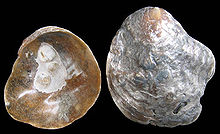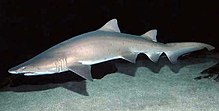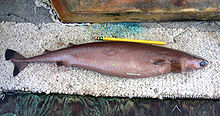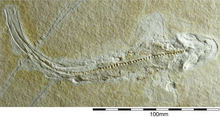User:Megalotitan/sandbox
| Northumberland Formation | |
|---|---|
| Stratigraphic range: Late Cretaceous, late | |
| Type | Geological formation |
| Unit of | Nanaimo Group |
| Underlies | Geoffery Formation |
| Overlies | De Courcy Formation |
| Location | |
| Country | |
The Northumberland Formation (previously also known as the Lambert Formation) is a Late Cretaceous geological formation exposed in the Hornby, Denman, Mayne, and Gabriola Islands, all located near Vancouver Island in British Columbia, Canada. Belonging to the larger Nanaimo Group, the Northumberland Formation has been dated to the upper Campanian, and numerous vertebrate, invertebrate, and plant fossils have been recovered from the formation, including birds, pterosaurs, sharks, coleoids, ammonites, angiosperms, and gymnosperms.[1][2][3][4][5]
Geology
[edit]The Northumberland Formation is exposed in small strips of the Gabriola and Mayne Islands,[6] east half of Denman Island,[7] and along the western to southeastern shores of Hornby Island.[5][7] All of these islands are situated east of Vancouver Island in the Strait of Georgia. Certain areas of Hornby Island that expose the Northumberland Formation were formerly mapped as the defunct Lambert Formation and the Spray Formation, being reassigned with evolving interpretations and nomenclature.[5] Part of the Nanaimo Group, the Northumberland Formation overlies the De Courcy Formation and underlies the nonfossiliferous Geoffrey Formation, both dominated by thick-bedded sandstone and conglomerate.[7]
Paleoenvironment
[edit]Various interpretations of the Northumberland Formation paleoenvironment have been proposed. A deep-water submarine fan complex has been put forth by several authors based on lithology.[7] Contrasting interpretations argue that the Northumberland Formation was deposited in a shallower environment. Jenkins et al. (2017) suggest an middle to outer shelf 100-300 m in depth based on macrofossil and lithological evidence, supported by foraminiferal data.
Paleobiota
[edit]Color key
|
Notes Uncertain or tentative taxa are in small text; |
Bivalves
[edit]| Bivalves | ||||||
|---|---|---|---|---|---|---|
| Genus | Species | Location | Stratigraphic position | Material | Notes | Images |
| Acila | A. grahami | Collishaw Point | Numerous shells |  | ||
| Amphidonte | A. parasitica[8] | Collishaw Point | ||||
| Anomia | A. vancouverensis[1] |  | ||||
| Caryocorbula | C. traskii[9][10] | Northwest side of Hornby Island | Three partial right valves |  | ||
| Glycymerita | G. veatchii[1] | Hornby Island | ||||
| Inoceramus | I. ex. gr. balticus | Collishaw Point | ||||
| I. (Platyceramus) cf. cycloides | ||||||
| I. ex gr. regularis | Collishaw Point | |||||
| I. vancouverensis[1] | Collishaw Point | |||||
| Nemodon | N. vancouverensis[1] | Collishaw Point | ||||
| Paraesa? | P.? lens[11] | Gabriola Island | ||||
| Solemya | S. sp.[1] | Collishaw Point |  | |||
| Teredina | T. suciensis[1] | Collishaw Point | ||||
Scaphopods
[edit]| Scaphopods | ||||||
|---|---|---|---|---|---|---|
| Genus | Species | Location | Stratigraphic position | Material | Notes | Images |
| Antalis | A. cooperi[1] | Collishaw Point |  | |||
Gastropods
[edit]| Gastropods | ||||||
|---|---|---|---|---|---|---|
| Genus | Species | Location | Stratigraphic position | Material | Notes | Images |
| Nonacteonina | N. sp.[1] | Collishaw Point | ||||
| Tessarolax | T. loullae[12] | Collishaw Point, Phipps Point | ||||
Ammonites
[edit]| Ammonites | ||||||
|---|---|---|---|---|---|---|
| Genus | Species | Location | Stratigraphic position | Material | Notes | Images |
| Anagaudryceras | A. politissimum[1] | Collishaw Point | ||||
| Baculites | B. occidentalis[5] | Southeastern shore of Hornby Island to Collishaw Point | Spans nearly the entirety of the Northumberland Formation | Includes material previously referred to B. chicoensis |  | |
| Diplomoceras | D. (Diplomoceras) cylindraceum[1][5] | Western coast of Hornby Island, from Shingle Spit to Collishaw Point; one isolated occurrence from southeastern shore[5] | Includes material previously referred to Hamites obstrictus |  | ||
| D. (Diplomoceras) cf. cylindraceum[5] | Mid-western coast of Hornby Island | Cannot be confidently assigned to D. (D.) cylindraceum, although fits within the parameters of the species | ||||
| Exiteloceras | E. (Exiteloceras) denicostatum[5] | Collishaw Point | Upper part of formation |  | ||
| E. (Neancyloceras) aff. bipunctatum[5] | Southeastern to mid-western shore of Hornby Island | Lower part of formation | ||||
| Fresvillia | F. constricta[5] | Western shore of Hornby Island, from Shingle Spit to Collishaw Point | ||||
| Gaudryceras | G. denmanense'[1] | Denman and Hornby Islands |  | |||
| G. aff. venustum[13] | Between Shingle Spit and Phipps Point | G. venustum now a junior synonym of G. izumiense | ||||
| G. sp.[14] | Between Shingle Spit and Savoie's wharf | Body chamber fragment of large individual | Ornamentation similar to G. mitis | |||
| Hypophylloceras | H. (Neophylloceras) ramosum[1] | Collishaw Point | ||||
| H. (Neophylloceras) hetonaiense[14] | North side of Hornby Island | Senior synonym of H. (N.) lambertense[15] | ||||
| H. (Neophylloceras) surya[1] | Collishaw Point | |||||
| Nostoceras | N. (Didymoceras?) adrotans[5] | Southeastern coast of Hornby Island | Lower part of formation | Includes nomen dubium Anisoceras cooperi |  | |
| N. (Nostoceras) hornbyense[1][5] | Western shores of Hornby Island, from Shingle Spit to Collishaw Point | Upper part of formation | ||||
| N. (Nostoceras) aff. pauper[5] | Western shores of Hornby Island, from Shingle Spit to Collishaw Point | Upper part of formation | ||||
| Pachydiscus | P. hornbyense[1] | Collishaw Point |  | |||
| P. cf. ootacodensis | ||||||
| P. suciaensis[1] | Collishaw Point | |||||
| Phyllopachyceras | P. forbesianum | |||||
| Phylloptychoceras | P. horitai[5] | Southeastern shore of Hornby Island to Collishaw Point | Spans nearly the entirety of the Northumberland Formation | |||
| Pseudophyllites | P. indra[1] | Collishaw Point | ||||
| Solenoceras | S. exornatus[5] | Southeastern shore of Hornby Island | Lower part of formation | |||
| S. cf. reesidei[5] | Collishaw Point | Upper part of formation | ||||
Coleoids
[edit]| Coleoids | ||||||
|---|---|---|---|---|---|---|
| Genus | Species | Location | Stratigraphic position | Material | Notes | Images |
| Actinosepia | A. canadensis[16][17] | Collishaw Point[1] | ||||
| Cyrtobelus | C. hornbyense | Collishaw Point[1] | ||||
| Enchoteuthis | E. sp.[18] |  | ||||
Crustaceans
[edit]| Crustaceans | ||||||
|---|---|---|---|---|---|---|
| Genus | Species | Location | Stratigraphic position | Material | Notes | Images |
| Archaeopus | A. hoploserratus[19] | "southeastern coast of Hornby Island"[19] | ||||
| A. vancouverensis[1][19][20] | Collishaw Point; "western coast of Hornby Island"[19] | |||||
| Bournelyreidus | B. grahamae[21] | near Collishaw Point | Carapace | |||
| Branchiocarcinus | B. sp.[22] | Collishaw Point | Carapace and incomplete legs | |||
| Homolopsis | H. sp.[1] | Collishaw Point | Carapace | |||
| Linuparus | L. vancouverensis[1] | Hornby Island |   | |||
| Sabellidromites | S. laneae[23] | "near Manning Point"[23] | Carapace and partial chelipeds | Initially incorrectly spelled as S. lanae | ||
| Ostracoda indet.[24] | ||||||
Insects
[edit]| Insects | ||||||
|---|---|---|---|---|---|---|
| Genus | Species | Location | Stratigraphic position | Material | Notes | Images |
| Curculionidae indet.[1] | Collishaw Point | Wing covers | ||||
| Isoptera indet.[1] | Collishaw Point | Galleries within fossil driftwood, containing fecal pellets | ||||
Echinoderms
[edit]| Echinoderms | ||||||
|---|---|---|---|---|---|---|
| Genus | Species | Location | Stratigraphic position | Material | Notes | Images |
| Echinoidea indet.[24] | Spines and plates | |||||
| Goniasteridae indet.[1] | Single incomplete arm | |||||
| Holothuria indet.[24] | ||||||
Sharks
[edit]All following information follows Cappetta, Morrison, & Adnet (2021),[25] unless stated otherwise.
| Sharks | ||||||
|---|---|---|---|---|---|---|
| Genus | Species | Location | Stratigraphic position | Material | Notes | Images |
| Carcharias | C. dominguei | Collishaw Point, Manning Point | Over 1000 teeth from Collishaw Point, 130 teeth from Manning Point |  | ||
| Centrosqualus | C. mustardi | Collishaw Point, Manning Point | 57 teeth from Collishaw Point, 34 teeth from Manning Point | |||
| Centroscymnus | C. sp. | Collishaw Point, Manning Point | 4 teeth from Collishaw Point, 2 teeth from Manning Point |  | ||
| Chlamydoselachus | C. balli | Collishaw Point, Manning Point | 1 tooth from Collishaw Point, 2 teeth from Manning Point |  | ||
| Dykeius | D. garethi | Collishaw Point, Manning Point | 7 teeth from Collishaw Point, 2 teeth from Manning Point | Estimated to be 7 m in length by Cappetta et al. | ||
| Echinorhinus | E. sp.[26] | Collishaw Point, Manning Point | 220 teeth from Collishaw Point, 43 teeth from Manning Point | Previously referred to E. lapaoi[25] |  | |
| cf. Eoetmopterus | cf. E. supracretaceus | Collishaw Point, Manning Point | 220 teeth from Collishaw Point, 43 teeth from Manning Point | Estimated to be around 50 cm in length by Cappetta et al. |  | |
| Florenceodon | F. johnyi | Collishaw Point, Manning Point | 136 teeth from Collishaw Point, 29 teeth from Manning Point | |||
| Hemiscyllium | H. hermani | Collishaw Point | 1 tooth |  | ||
| Hessinodon | H. wardi | Collishaw Point, Manning Point | 2 teeth from Collishaw Point, 2 teeth from Manning Point |  | ||
| Hexanchus | H. microdon | Collishaw Point, Manning Point | 395 lower teeth from Collishaw Point, 151 lower teeth from Manning Point; numerous upper teeth from both sites |  | ||
| Komoksodon | K. kwutchakuth | Collishaw Point, Manning Point | 60 teeth from Collishaw Point, 26 teeth from Manning Point | |||
| Meristodonoides | M. sp. | Collishaw Point | 1 tooth |  | ||
| Notidanodon | N. pectinatus | Collishaw Point, Manning Point | 33 teeth from Collishaw Point, 14 teeth from Manning Point | |||
| Paraorthacodus | P. rossi | Collishaw Point, Manning Point | 28 teeth from Collishaw Point, 7 teeth from Manning Point |  | ||
| Plicatoscyllium | P. cf. globidens | Collishaw Point | 1 tooth |  | ||
| Pristiophorus | P. pricei | Collishaw Point | 30 teeth |   | ||
| P. smithi | Collishaw Point, Manning Point | 63 teeth from Collishaw Point, 1 tooth from Manning Point | ||||
| Protocentrophorus | P. steviae | Collishaw Point, Manning Point | 82 teeth from Collishaw Point, 39 teeth from Manning Point |  | ||
| Protoheptranchias | P. lowei | Collishaw Point, Manning Point | 197 teeth from Collishaw Point, 58 teeth from Manning Point |  | ||
| Rhinoscymnus | R. clarki | Manning Point | 1 tooth |  | ||
| Rolfodon | R. ludvigseni | Collishaw Point, Manning Point | 213 teeth from Collishaw Point, 26 teeth from Manning Point | |||
| R. cf. thomsoni | Manning Point | 1 tooth | ||||
| Squaliodalatias | S. savoiei | Collishaw Point, Manning Point | 334 teeth from Collishaw Point, 74 teeth from Manning Point |  | ||
| Squalus | S. nicholsae | Collishaw Point, Manning Point | 107 teeth from Collishaw Point, 27 teeth from Manning Point | Notably large size compared to other Cretaceous Squalus species |  | |
| S. vondermarcki | Collishaw Point, Manning Point | 258 teeth from Collishaw Point, 85 teeth from Manning Point | Differs slightly from holotypic teeth from Campanian Germany, warrants taxonomic reanalysis[27] | |||
| S. sp. | Collishaw Point | 1 tooth | ||||
| Synechodus | S. dereki | Collishaw Point, Manning Point | 48 teeth from Collishaw Point, 4 teeth from Manning Point |  | ||
| Xampylodon | X. dentatus | Collishaw Point, Manning Point | 22 teeth from Collishaw Point, 7 teeth from Manning Point | Estimated to be 3-4 m in length by Cappetta et al. | ||
| Scyliorhinidae indet. | Collishaw Point | 1 tooth |   | |||
Osteichthyans
[edit]| Osteichthyans | ||||||
|---|---|---|---|---|---|---|
| Genus | Species | Location | Stratigraphic position | Material | Notes | Images |
| Enchodontidae indet.[1] | Collishaw Point | Lower jaw |  | |||
| Saurodontidae indet.[28] | Collishaw Point | Left? maxilla | Holotype of Gwawinapterus beardi, previously thought to be an istiodactylid pterosaur[29] |  | ||
Archosaurs
[edit]| Archosaurs | ||||||
|---|---|---|---|---|---|---|
| Genus | Species | Location | Stratigraphic position | Material | Notes | Images |
| Maaqwi | M. cascadensis | Near Phipps Point | Associated right coracoid, humerus, ulna, and radius | Coracoid previously described as Ornithurae indet.[3] |  | |
| Azhdarchidae? indet.[4] | Collishaw Point | Associated humerus, dorsal vertebrae, and indeterminate bone fragments; likely one individual | ||||
| Crocodylia indet.[3] | "a series of sites at Collishaw and Manning points"[3] | |||||
| Euenantiornithes indet.[2][3] | Collishaw Point | Right radius, left coracoid,[2] and left femur[3] from different individuals | Marked size difference between radius and coracoid | |||
| Ornithurae indet.[2][3] | Collishaw Point | Two left tarsometatarsi from different taxa; two distal ulnae of distinct sizes; left tibiotarsus;[2] left carpometacarpus[3] | ||||
Non-archosaur reptiles
[edit]| Non-archosaur reptiles | ||||||
|---|---|---|---|---|---|---|
| Genus | Species | Location | Stratigraphic position | Material | Notes | Images |
| Tylosaurus | T. sp.[1] | Collishaw Point | Partial skull |  | ||
| Mosasauridae indet.[1] | Collishaw Point | Isolated teeth | ||||
| Testudines indet.[3] | "a series of sites at Collishaw and Manning points"[3] | |||||
Mammals
[edit]| Mammals | ||||||
|---|---|---|---|---|---|---|
| Genus | Species | Location | Stratigraphic position | Material | Notes | Images |
| Multituberculata indet.[25] | Undescribed tooth | |||||
Plants
[edit]| Ferns | ||||||
|---|---|---|---|---|---|---|
| Genus | Species | Location | Stratigraphic position | Material | Notes | Images |
| Appendicisporites | A. sp. | |||||
| Aquilapollenites | A. quadrilobus | |||||
| Atli | A. morinii | Collishaw Point | Stem segment | |||
| Baculatisporites | B. sp. | Reported as "Baculitesporites" (lapsus calami) | ||||
| Cibotiumspora | C. sp. | |||||
| Cicatricososporites | C. norrisii | |||||
| Cingutriletes | C. sp. | |||||
| Clavifera | C. sp. | |||||
| Cunninghamia | C. hornbyensis | Collishaw Point | Twigs and leaves |  | ||
| Cyathidites | C. minor | |||||
| C. sp. | ||||||
| Cycadeoidea | C. maccafferyi | Collishaw Point | Ovulate cones | |||
| Dictyophyllidites | D. sp. | Reported as "Dictyophyllites" (lapsus calami) | ||||
| Foraminisporis | F. asymmetricus | |||||
| Gleicheniidites | G. spp. | |||||
| Hamulatisporis | H. sp. | |||||
| Mancicorpus | M. tripodiformis | |||||
| Marcellopites | M. tolmanensis | |||||
| Microcachryidites | M. sp. | |||||
| Murospora? | M.? sp. | |||||
| Parviprojectus | P. trialatus | |||||
| Pilosisporites | P. sp. | |||||
| Picea | P. spp. | |||||
| Reticorpus | R. delicatus | |||||
| R. senonicus | ||||||
| Retitriletes | R. sp. | |||||
| Sabalites | S. sp.[1] | Collishaw Point | Leaf-stalks |  | ||
| Siberiapollis | S. spp. | |||||
| Tricolpites | T. sp. | |||||
| Trilobosporites | T. sp. | |||||
| Triprojectus | T. attenuatus | |||||
| T. minshuensis | ||||||
| Trudopollis | T. meekeri | |||||
| T. sp. | ||||||
| Tschudypollis | T. retusus | |||||
| T. thalmannii | ||||||
| Varirugosisporites | T. meekeri | |||||
See also
[edit]Footnotes
[edit]References
[edit]- ^ a b c d e f g h i j k l m n o p q r s t u v w x y z aa ab ac ad Ludvigsen, Rolf; Beard, Graham (1997). West Coast fossils: a guide to the ancient life of Vancouver Island (2nd ed.). Harbour Publishing. p. 216. ISBN 1-55017-179-8.
- ^ a b c d e Morrison, Kurt; Dyke, Gareth J.; Chiappe, Luis M. (2005). "Cretaceous fossil birds from Hornby Island (British Columbia)". Canadian Journal of Earth Sciences. 42 (12): 2097–2101. doi:10.1139/e05-081.
- ^ a b c d e f g h i j Dyke, Gareth; Wang, Xia; Kaiser, Gary (2011). "Large fossil birds from a Late Cretaceous marine turbidite sequence on Hornby Island (British Columbia)". Canadian Journal of Earth Sciences. 48 (11): 1489–1496. doi:10.1139/e11-050.
- ^ a b Martin-Silverstone, Elizabeth; Witton, Mark P.; Arbour, Victoria M.; Currie, Phillip J. (2016). "A small azhdarchoid pterosaur from the latest Cretaceous, the age of flying giants". Royal Society Open Science. 3 (8). doi:10.1098/rsos.160333.
- ^ a b c d e f g h i j k l m n o p McLachlan, Sandy M. S.; Haggart, James W. (2018). "Reassessment of the late Campanian (Late Cretaceous) heteromorph ammonite fauna from Hornby Island, British Columbia, with implications for the taxonomy of the Diplomoceratidae and Nostoceratidae". Journal of Systematic Paleontology. 16 (15): 1247–1299. doi:10.1080/14772019.2017.1381651.
- ^ Englert, Rebecca G.; Hubbard, Stephen M.; Coutts, Daniel S.; Matthews, William A. (2018). "Tectonically controlled initiation of contemporaneous deep-water channel systems along a Late Cretaceous continental margin, western British Columbia, Canada". Sedimentology. 65 (7): 2404–2438. doi:10.1111/sed.12472.
- ^ a b c d Katnick, Deanne C.; Mustard, Peter S. (2003). "Geology of Denman and Hornby islands, British Columbia: implications for Nanaimo Basin evolution and formal definition of the Geoffrey and Spray formations, Upper Cretaceous Nanaimo Group". Canadian Journal of Earth Sciences. 40 (3): 375–393. doi:10.1139/e03-005.
- ^ Squires, Richard L. (2017). "Late Cretaceous oysters from the Pacific slope of North America: Revision of named species and discovery of new species". Contributions in Science. 525: 25 53. doi:10.5962/p.318346.
- ^ Whiteaves, Joseph F. (1879). "On the fossils of the Cretaceous rocks of Vancouver and adjacent islands in the Strait of Georgia". Geological Survey of Canada. 1 (2): 93–190. doi:10.4095/216116.
- ^ Squires, Richard L.; Saul, Louella R. (2004). "Cretaceous corbulid bivalves of the Pacific slope of North America". The Veliger. 47 (2): 103–129.
- ^ Saul, L. R. (1993). "Pacific Slope Cretaceous bivalves: eight venerid species". Journal of Paleontology. 67 (6): 965–979. doi:10.1017/S0022336000025282.
- ^ Saul, Louella R.; Squires, Richard L. (2015). "Pacific slope of North America record of the Cretaceous Aporrhaid Gastropod Tessarolax: Evolutionary trends, mode of life, and paleobiogeography of the genus". Contributions in Science. 523: 37–65. doi:10.5962/p.318346.
- ^ Haggart, James W. (1989). "New and revised ammonites from the Upper Cretaceous Nanaimo group of British Columbia and Washington state". Geological Survey of Canada. 396: 181–221. doi:10.4095/127723.
- ^ a b Usher, J. L. (1952). "Ammonite faunas of the Upper Cretaceous rocks of Vancouver Island, British Columbia". Geological Survey of Canada. 21: 1–182. doi:10.4095/101522.
- ^ Jones, David L. (1963). "Upper Cretaceous (Campanian and Maestrichtian) ammonites from southern Alaska". U.S. Geological Survey Professional Paper. 432: 1–53. doi:10.3133/pp432.
- ^ Tanabe, Kazushige; Trask, Pat; Ross, Rick; Hikida, Yoshinori (2008). "Late Cretaceous octobrachiate coleoid lower jaws from the north Pacific regions". Journal of Paleontology. 82 (2): 398–408. doi:10.1666/07-029.1.
- ^ Larson, Neal L. (2010). "Fossil Coleoids from the Late Cretaceous (Campanian & Maastrichtian) of the Western Interior". Ferrantia. 59: 78–113.
- ^ Fuchs, Dirk; Iba, Yasuhiro; Heyng, Alexander; Iijima, Masaya; Klug, Christian; Larson, Neal L.; Schweigert, Günter (2020). "The Muensterelloidea: phylogeny and character evolution of Mesozoic stem octopods". Papers in Palaeontology. 6 (1): 31–92. doi:10.1002/spp2.1254.
- ^ a b c d Nyborg, Torrey; McLachlan, Sandy M. S.; Garassino, Alessandro; Vega, Francisco J.; Phillippe, Steven C.; Champagne, Donald E. (2019). "New and revised species of Archaeopus Rathbun, 1908 (Decapoda: Brachyura: Retroplumidae) from the eastern Pacific". Neues Jahrbuch für Geologie und Paläontologie - Abhandlungen. 292 (1): 25–56. doi:10.1127/njgpa/2019/0807.
- ^ Schweitzer, Carrie E.; Feldmann, Rodney M.; Fam, John; Hessin, William A.; Hetrick, Steven W.; Nyborg, Torrey G.; Ross, Richard L.M. (2003). Cretaceous and Eocene Decapod Crustaceans from Southern Vancouver Island, British Columbia, Canada. Ottawa, Ontario, Canada: NRC Research Press. p. 1–66. doi:10.1139/9780660190921. ISBN 0-660-19092-3.
- ^ Nyborg, Torrey; Garassino, Alessandro; Vega, Francisco J.; Ross, Richard L. M. (2024). "A new fossil frog crab (Brachyura, Raninoidea) from the late Campanian of Hornby Island (British Columbia, Canada)". Neues Jahrbuch für Geologie und Paläontologie - Abhandlungen. 310 (3): 209–217. doi:https://doi.org/10.1127/njgpa/2023/1177.
{{cite journal}}: Check|doi=value (help); External link in|doi= - ^ Nyborg, Torrey; Ossó, Àlex; Vega, Francisco J. (2014). "A new species of icriocarcinid crab (Crustacea, Portunoidea) from the uppermost Cretaceous of California, USA: palaeobiogeographic implications". Scripta Geologica. 147: 83–93.
- ^ a b Nyborg, Torrey; Garassino, Alessandro; Ross, Richard L. M. (2020). "A new dromioid crab from the late Campanian of Hornby Island, Canada". Neues Jahrbuch für Geologie und Paläontologie - Abhandlungen. 295 (2): 141–147. doi:10.1127/njgpa/2020/0878.
- ^ a b c McGugan, Alan (1979). "Biostratigraphy and paleoecology of Upper Cretaceous (Campanian and Maestrichtian) foraminifera from the Upper Lambert, Northumberland, and Spray Formations, Gulf Islands, British Columbia, Canada". Canadian Journal of Earth Sciences. 16 (12): 2263–2274. doi:10.1139/e79-211.
- ^ a b c Cappetta, Henri; Morrison, Kurt; Adnet, Sylvain (2021). "A shark fauna from the Campanian of Hornby Island, British Columbia, Canada: an insight into the diversity of Cretaceous deep-water assemblages". Historical Biology. 33 (8): 1121–1182. doi:10.1080/08912963.2019.1681421.
- ^ Bogan, Sergio; Agnolín, Federico L. (December 2022). "The fossil record of the Bramble-shark Echinorhinus (Echinorhiniformes, Echinorhinidae) in South America". Journal of South American Earth Sciences. 120: 104083. doi:10.1016/j.jsames.2022.104083.
- ^ Pollerspöck, Jürgen; Beaury, Bernhard; Straube, Nicolas; Feichtinger, Iris (2021). "Oldest evidence of the genus Squalus in the north alpine realm with remarks on its evolution and distribution through time" (PDF). Paleoichthys. 2: 1–9.
- ^ Vullo, Romain; Buffetaut, Eric; Everhart, Michael J. (September 2012). "Reappraisal of Gwawinapterus beardi from the Late Cretaceous of Canada: a saurodontid fish, not a pterosaur". Journal of Vertebrate Paleontology. 32 (5): 1198–1201. doi:10.1080/02724634.2012.681078.
- ^ Arbour, Victoria M.; Currie, Philip J. (January 2011). "An istiodactylid pterosaur from the Upper Cretaceous Nanaimo Group, Hornby Island, British Columbia, Canada" (PDF). Canadian Journal of Earth Sciences. 48 (1): 63–69. doi:10.1139/E10-083.

